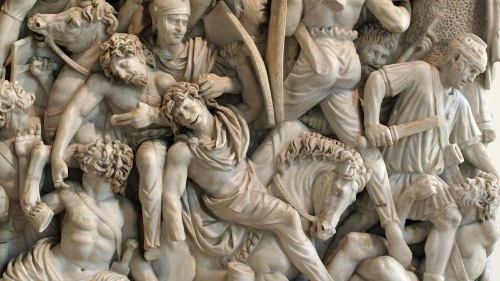
The Grande Ludovisi Sarcophagus, c. 250 C.E.
It may just be my historical imagination run amok (as it tends to do), but I see traces of the momentous struggle between ancient Romans and their German antagonists still drawing breath in the low-level but persistent rivalry between wine drinkers and beer lovers. The crudely binary nature of this contest is daily re-enacted and reinforced in popular culture, especially in advertising, where wine fanciers are presented as latter-day Romans, heirs of a literate, cosmopolitan, elitist tradition, and beer drinkers as level-headed, solid citizen types whose horizons are mainly bounded by their families and local communities, and for whom the putting on of airs of any stripe is a kind of capital crime.
If this were WWF we could bill it as Toga vs. Trousers: The Rematch, though neither side is likely to enter the ring.
I am not (entirely) making this up. The idea has its roots in University of Bologna professor Massimo Montanari’s wonderful little book, The Culture of Food published in 1996, where the author is at pains to point out a fundamental difference between how Romans and Germans conceived of and used land.
Per Professor Montenari, the ideal classical landscape was one that had been transformed by the hand of man. Romans delighted in the fields and pastures which, neatly divided by hedgerows and low stonewalls, served as a theater for the practice of rational agriculture. Mountains, forests, fens and other places unreclaimed from the domain of pure nature were, for them, alien geographies: dark, forbidding, feral realms that were fundamentally inhuman.
For animist Germans, on the other hand, the wild was a wonderfully compelling space, rife with sacred springs and hallowed oaks. These were not only places where the volk felt completely at home — they were essential sources of its physical and spiritual sustenance. In this alternative sensibility, nature is something holy, eternal and nurturing; in no sense alien. Seeking to dominate, reorder or somehow subdue it is conceived as a kind of sacrilege.
But this is, after all, a wine column, so rather than dwell on the semiotics of the ancient grape/grain opposition, I’ll take the contest in-house, so to speak. Wine drinkers have their own cultural issues over which to contend .
I don’t think it’s stretching it to say that the natural wine movement (for rhetorical purposes I’m conflating a set of loosely-related ideas and practices in this one too-handy phrase) has powerful affiliations with proto-Germanic nature philosophy. These include a tendency to value the primitive over the sophisticated and the accidental over the intentional, as well as an inclination to devalue attempts to alter nature in any way intended to make it more conformable to human need. (Forgive me, Teutonics, for speaking for you. I know it’s just the sort of thing you hate.)
More specifically, the set of vineyard practices known as biodynamics is directly connected to this tradition via its founder, the Austrian-born visionary theosophist Rudolf Steiner, whose emphasis on the importance of lunar phases, harmonic vibrations, and universal energy aimed at returning the farm to the primitive health of which it had been robbed by modern, agri-tech. Today, biodynamics is a touchstone for natural winemaking, and one cannot fail to be moved by the respectful, cautious, humane nature of its practice when compared with the environmentally brutal, industrial-scale monoculture that it yearns to overturn.
Today, the dividing line between the two camps can seem as definitive a boundary as the Rhine once was between warring Romans and Germans.
In the end, it was less a case of one people conquering and displacing another as of the two reaching a kind of rough settlement by which a fresh, hybrid culture emerged. As the tale is told by Mr. Gibbon, it all took a very long time. Can the wine world do the same at an accelerated pace? We’d like to think it’s already afoot.